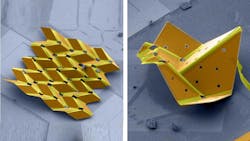Smart Materials Behave Like Robots
Unique robotic-like, thin, two-dimensional (2D) materials capable of holding programmed shapes have been developed by U.S. Army-funded researchers at Cornell University. The 2D materials can be formed into three-dimensional (3D) forms using applied voltage, holding the new shape after the voltage is removed. The researchers demonstrated the effectiveness of the novel material by using it to create what is thought to be the world’s smallest self-folding origami bird (see the figure; the material itself is at left and the bird at right). The research team also includes members from the National Science Foundation (NSF) and the U.S. Air Force Office of Scientific Research (AFOSR).
The material consists of a thin layer of platinum with titanium (Ti) or titanium-dioxide (TiO2) film. It could be the basis for high-resolution sensors and nanosized robots. Dr. Dean Culver, program manager for Complex Dynamics and Systems at Army Research Office, an element of the U.S. Army Combat Capabilities Development Command (DEVCOM) Army Research Laboratory (ARL), said: “The research team is pushing the boundary of how quickly and precisely we can control motion at the micro- and even nano-scale. In addition to paving the way for nano-robots, the scientific advancements from this effort can enable smart-material design and interaction with the molecular biological world that can assist the Army like never before.”
Professor Paul McEuen, the John A. Newman Professor of Physical Science at Cornell University, added: “We humans, our defining characteristic is we’ve learned how to build complex systems and machines at human scales, and at enormous scales as well. What we haven’t learned how to do is build machines at tiny scales.” One of the goals of the material research is to create cell-sized robots with artificial intelligence (AI) and integrated microprocessors that are capable of biological applications on a micron-sized molecular scale. The shape shifting memory actuators developed by the researchers can bend with a radius of less than 1 μm. They can change shapes within milliseconds in response to an applied voltage and they can be flattened and reformed thousands of times with low control voltages.
About the Author
Jack Browne
Technical Contributor
Jack Browne, Technical Contributor, has worked in technical publishing for over 30 years. He managed the content and production of three technical journals while at the American Institute of Physics, including Medical Physics and the Journal of Vacuum Science & Technology. He has been a Publisher and Editor for Penton Media, started the firm’s Wireless Symposium & Exhibition trade show in 1993, and currently serves as Technical Contributor for that company's Microwaves & RF magazine. Browne, who holds a BS in Mathematics from City College of New York and BA degrees in English and Philosophy from Fordham University, is a member of the IEEE.
